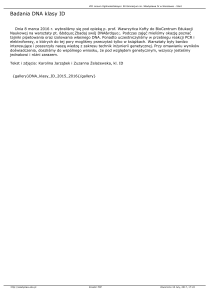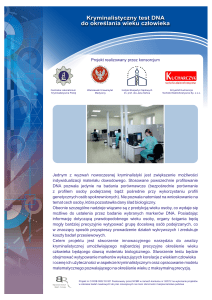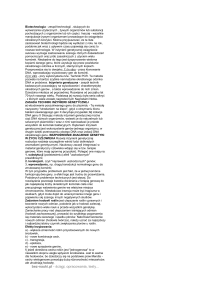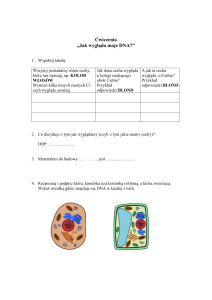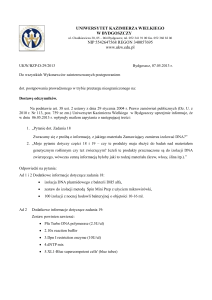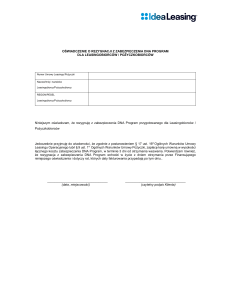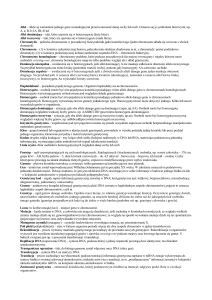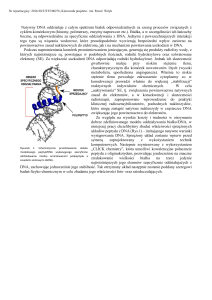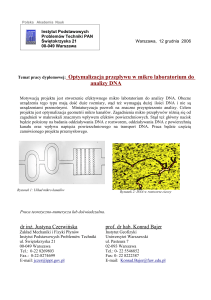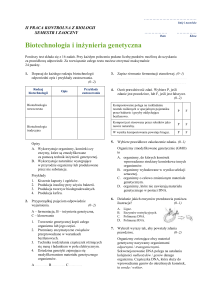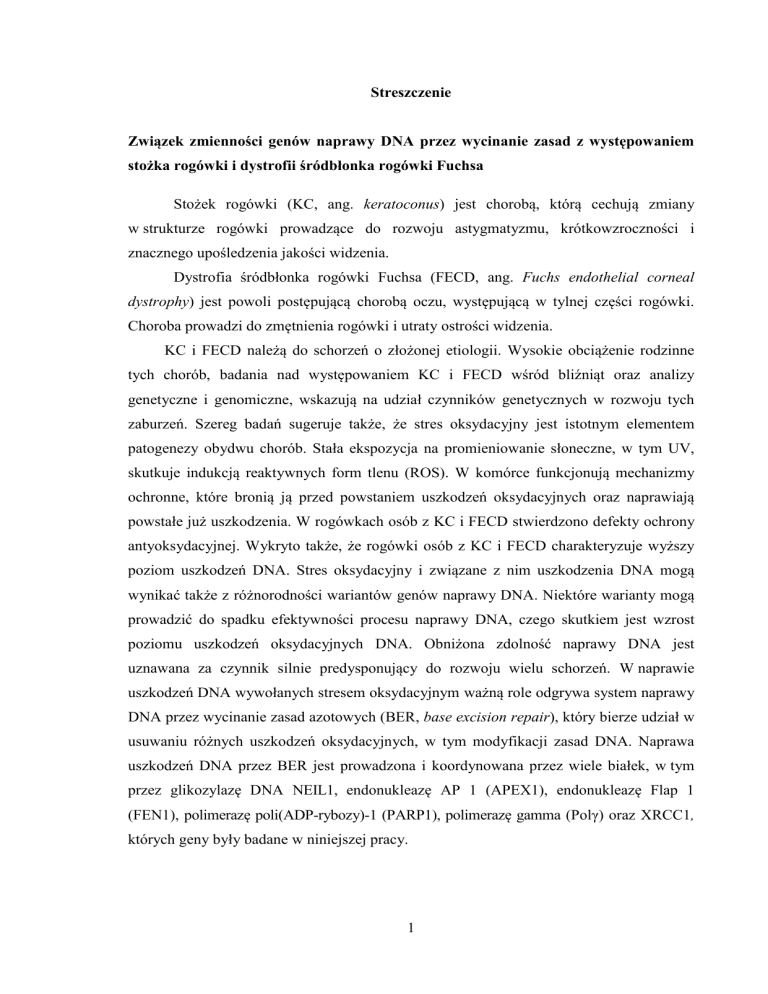
Streszczenie
Związek zmienności genów naprawy DNA przez wycinanie zasad z występowaniem
stożka rogówki i dystrofii śródbłonka rogówki Fuchsa
Stożek rogówki (KC, ang. keratoconus) jest chorobą, którą cechują zmiany
w strukturze rogówki prowadzące do rozwoju astygmatyzmu, krótkowzroczności i
znacznego upośledzenia jakości widzenia.
Dystrofia śródbłonka rogówki Fuchsa (FECD, ang. Fuchs endothelial corneal
dystrophy) jest powoli postępującą chorobą oczu, występującą w tylnej części rogówki.
Choroba prowadzi do zmętnienia rogówki i utraty ostrości widzenia.
KC i FECD należą do schorzeń o złożonej etiologii. Wysokie obciążenie rodzinne
tych chorób, badania nad występowaniem KC i FECD wśród bliźniąt oraz analizy
genetyczne i genomiczne, wskazują na udział czynników genetycznych w rozwoju tych
zaburzeń. Szereg badań sugeruje także, że stres oksydacyjny jest istotnym elementem
patogenezy obydwu chorób. Stała ekspozycja na promieniowanie słoneczne, w tym UV,
skutkuje indukcją reaktywnych form tlenu (ROS). W komórce funkcjonują mechanizmy
ochronne, które bronią ją przed powstaniem uszkodzeń oksydacyjnych oraz naprawiają
powstałe już uszkodzenia. W rogówkach osób z KC i FECD stwierdzono defekty ochrony
antyoksydacyjnej. Wykryto także, że rogówki osób z KC i FECD charakteryzuje wyższy
poziom uszkodzeń DNA. Stres oksydacyjny i związane z nim uszkodzenia DNA mogą
wynikać także z różnorodności wariantów genów naprawy DNA. Niektóre warianty mogą
prowadzić do spadku efektywności procesu naprawy DNA, czego skutkiem jest wzrost
poziomu uszkodzeń oksydacyjnych DNA. Obniżona zdolność naprawy DNA jest
uznawana za czynnik silnie predysponujący do rozwoju wielu schorzeń. W naprawie
uszkodzeń DNA wywołanych stresem oksydacyjnym ważną role odgrywa system naprawy
DNA przez wycinanie zasad azotowych (BER, base excision repair), który bierze udział w
usuwaniu różnych uszkodzeń oksydacyjnych, w tym modyfikacji zasad DNA. Naprawa
uszkodzeń DNA przez BER jest prowadzona i koordynowana przez wiele białek, w tym
przez glikozylazę DNA NEIL1, endonukleazę AP 1 (APEX1), endonukleazę Flap 1
(FEN1), polimerazę poli(ADP-rybozy)-1 (PARP1), polimerazę gamma (Polγ) oraz XRCC1,
których geny były badane w niniejszej pracy.
1
Celem pracy było określenie roli zmienności genów naprawy DNA przez
wycinanie zasad azotowych w patogenezie stożka rogówki i dystrofii śródbłonka rogówki
Fuchsa.
Materiał do badań stanowiły próbki krwi obwodowej pobrane od pacjentów z KC,
FECD i osób z grupy kontrolnej, u których wykluczono obecność tych chorób. Genomowy
DNA będący materiałem do analizy polimorfizmów wyizolowano z krwi obwodowej przy
użyciu zestawu AxyPrep™ Blood Genomic DNA Miniprep Kit (Axygen Biosciences,
Union City, CA, USA).
Analizie poddano 9 polimorfizmów:
2 polimorfizmy genu FEN1: c.–441G>A (rs174538), g.61564299G>T (rs4246215),
2 polimorfizmy genu APEX1: c.444T>G (rs1130409), c.–468T>G (rs1760944),
polimorfizm g.46438521G>C (rs4462560) genu NEIL1,
polimorfizm c.2285T>C (rs1136410) genu PARP-1,
polimorfizm c.–1370T>A (rs1054875) genu POLG,
2 polimorfizmy genu XRCC1: c.580C>T (rs1799782), c.1196A>G (rs25487).
Do genotypowania polimorfizmów zastosowano technikę PCR-RFLP (polimorfizm
długości
fragmentów
restrykcyjnych),
analizę
krzywych
topnienia
o
wysokiej
rozdzielczości (HRM, High Resolution Melt) i metodą RT-PCR z użyciem sondy TaqMan.
Rezultaty otrzymane w toku badań wskazują na wyższą częstość występowania KC
wśród osób płci męskiej, u osób z wadami wzroku, alergiami oraz wśród pacjentów z
obciążeniem rodzinnym tą chorobą. Dodatkowo średnia wieku osób z KC była niższa
(wynosiła ok. 36 lat) w stosunku do grupy kontrolnej (ok. 63 lat), dlatego też wiek został
uwzględniony w dalszej części badań jako czynnik ryzyka tej chorob. Przeprowadzona
analiza OR wykazała, że genotyp T/T polimorfizmu g.61564299G>T genu FEN1
związany jest ze zwiększoną częstością występowania KC. Stwierdzono, że genotyp T/T
polimorfizmu c.–468T>G genu APEX1 jest pozytywnie skorelowany z występowaniem
KC, podczas gdy genotyp G/T tego polimorfizmu związany jest ze zmniejszoną częstością
występowania tej choroby. Genotyp A/A polimorfizmu c.–1370T>A genu POLG
związany jest ze zwiększoną, a genotyp A/T ze zmniejszoną częstością występowania KC.
Genotyp A/G oraz allel A polimorfizmu c.1196A>G genu XRCC1 związane są ze
zwiększoną częstością występowania KC, podczas gdy genotyp G/G i allel G wykazują
odwrotną korelacje. Genotyp C/T oraz allel T polimorfizmu c.580C>T genu XRCC1
związane są ze zwiększoną częstością występowania KC, podczas gdy genotyp C/C
2
wykazuje
odwrotny
związek.
Nie
stwierdzono
korelacji
między
rozkładem
genotypów/alleli polimorfizmów: c.–441G>A genu FEN1, c.444T>G genu APEX1,
g.46438521G>C genu NEIL1 i c.2285T>C genu PARP-1, a zmianą częstości występowania
KC. Obserwowano związek pomiędzy haplotypami polimorfizmów g.61564299G>T i c.–
441G>A genu FEN1 oraz c.1196A>G i c.580C>T genu XRCC1, a zmianą częstości
występowania KC.
Zaobserwowano, że płeć żeńska, starszy wiek, obciążenie FECD w rodzinie
i współwystępowanie zaburzeń widzenia są pozytywnie skorelowane z występowaniem
FECD. Otrzymane wyniki wskazują, że genotyp T/T polimorfizmu g.61564299G>T genu
FEN1 związany jest ze zwiększoną częstością występowania FECD. Nie stwierdzono
istotnie statystycznie różnic w częstości genotypów/alleli polimorfizmów: c.–441 G>A
genu FEN1 c.444T>G i c.–468T>G APEX1 a występowaniem FECD. Zaobserwowano
związek pomiędzy rozkładem haplotypów polimorfizmów g.61564299G>T i c.–441G>A
genu FEN1 a występowaniem FECD.
Podsumowując, wyniki uzyskane w toku realizacji pracy doktorskiej, stanowią
podstawę do stwierdzenia, iż zmienność w genach naprawy DNA przez wycinanie zasad
azotowych może mieć istotne znaczenie dla występowania KC i FECD.
3
Summary
Variation in DNA base excision repair genes in keratoconus and Fuchs endothelial
corneal dystrophy
Keratoconus (KC) is a disease that is characterized by changes in the structure of
the cornea leading to the development of corneal astigmatism, myopia and significant
deterioration of vision.
Fuchs endothelial corneal dystrophy (FECD) is a slowly progressive eye disease
that affects posterior layers of the cornea. In the advanced stages of this disease,
endothelial cell thinning induces corneal edema and loss of vision.
KC and FECD are diseases with complex etiologies. High familial aggregation of
these diseases, twin studies, as well as results of many genetic and genomic analyses,
indicate the involvement of genetic factors in their development. Moreover, a number of
studies suggest that oxidative stress is associated with the pathogenesis of both diseases.
Constant exposure to sunlight, including ultraviolet (UV) radiation, induces reactive
oxygen species (ROS). Antioxidant defense mechanisms operating in the cells neutralize
ROS and repair damage resulted from their action. A growing body of evidence shows
disturbances in antioxidant defense system in corneas with FECD and KC. It was also
detected that KC and FECD corneas had a higher level of DNA damage. Oxidative stress
and oxidative DNA damage may result from the variability of DNA repair genes. The
variation in these genes may lead to a decrease in the efficiency of the DNA repair,
resulting in an increase in the level of oxidative DNA damage. A reduced ability to repair
DNA damage is associated with the development of several diseases. Base excision repair
(BER) system plays an important role in the repair of DNA damage induced by oxidative
stress. BER is involved in the removal of various oxidative damages, including DNA base
modifications. Repair of DNA damage by the BER is processed and coordinated by several
proteins, including DNA glycosylase ‒ endonuclease VIII-like 1 (NEIL1), APEX nuclease
1 (APEX1), Flap endonuclease 1 (FEN1), poly (ADP-ribose) polymerase 1 (PARP-1),
DNA polymerase gamma (Polγ) and X -ray repair cross-complementing protein 1
(XRCC1).
The purpose of these investigations was to elucidate the role of variation in base
excision repair genes in the pathogenesis of keratoconus and Fuchs endothelial corneal
dystrophy.
4
The study was performed on blood samples obtained from KC, FECD patients and
individuals with FECD/KC exclusion ‒ control subjects. Genomic DNA was extracted
from venous blood using the commercially available AxyPrep™ Blood Genomic DNA
Miniprep Kit (Axygen Biosciences, Union City, CA, USA).
This research involved nine polymorphisms:
c.–441G>A (rs174538) and g.61564299G>T (rs4246215) in the FEN1 gene,
c.444T>G (rs1130409) and c.–468T>G (rs1760944) in the APEX1,
g.46438521G>C (rs4462560) in the NEIL1 gene,
c.2285T>C (rs1136410) in the PARP-1 gene,
c.–1370T>A (rs1054875) in POLG gene,
c.580C>T (rs1799782) and c.1196A>G (rs25487) in the XRCC1 gene.
Genotyping of polymorphisms was performed by the polymerase chain reaction-
restriction fragment length polymorphism (PCR-RFLP) method, high-resolution melting
curve analysis (HRM) and the TaqMan® SNP Genotyping Assay.
Results of the experiments indicated that male sex, co-occurrence of visual
disturbances, allergies and positive family history for KC significantly increased the
occurrence of KC. In addition, the average age of the KC patients was significantly lower
(about 36 years) compared to the control group (around 63 years), therefore the age was
assumed as a risk factor for the disease in the further part of the study. The analysis
showed that the T/T genotype of g.61564299G>T polymorphism of the FEN1 gene was
associated with an increased KC occurrence. It was found that the T/T genotype of
c.‒468T>G polymorphism of the APEX1 gene was positively correlated with KC
occurrence, while the G/T genotype of this polymorphism was associated with a decreased
occurrence of the disease. The A/A genotype of c.‒1370T>A polymorphism of the POLG
gene was associated with an increased, whereas the A/T genotype with a decreased KC
occurrence. The A/G genotype and A allele of the c.1196A>G polymorphism of XRCC1
were associated with an increased KC occurrence, while the G/G genotype and G allele
exhibited opposite tendency. The C/T genotype and T allele of the c.580C>T
polymorphism of the XRCC1 gene were associated with an increased KC occurrence,
while the C/C genotype showed opposite relationship. There was no association between
the distribution of genotypes/alleles of c.‒441G>A ‒ FEN1, c.444T>G ‒ APEX1,
g.46438521G>C ‒ NEIL1 and c.2285T>C ‒ PARP-1, polymorphisms and KC occurrence.
Associations between haplotypes of the g.61564299G>T and c.‒441G>A polymorphisms
5
of the FEN1 gene and c.1196A>G and c.580C>T polymorphisms of the XRCC1 and KC
occurrence were observed.
It was found that female sex, older age, positive family history for FECD and cooccurrence of visual disturbances were positively correlated with FECD occurrence. The
results showed that the T/T genotype of the g.61564299G>T polymorphism of the FEN1
gene was associated with an increased FECD occurrence. There were no statistically
significant differences in the frequency of genotypes/alleles of the c.‒441G>A ‒ FEN1
c.444T>G ‒ APEX1, c.‒468T>G ‒ APEX1 polymorphisms and FECD occurrence.
Haplotypes of the g.61564299G>T, c.‒441G>A of the FEN1 gene were associated with
FECD occurrence.
In conclusion, genetic variability of base excision repair genes may be important
for KC and FECD occurrence.
6

